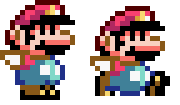A sprite is a 2d computer graphic. Usually a raster graphic, but vector graphics qualify as well. They can be used for all kinds of graphics-related projects like animations, comic strips, or anything else. Usually, “sprite” is used in the context of video games. For example, take the Mario character from Super Mario World:
This animation is composed of two sprites – one with Mario’s feet together and one with his feet apart. The animation itself could be considered a sprite as well.
Take a look at that Mario sprite again. Can you tell exactly what each frame of the animation looks like? Try blinking really quickly, which might help a little, but I’d be surprised if you could precisely redraw each frame without stopping the animation.
Essentially, sprite sheets are stopped animations. Each frame of an animation (or just a single frame if the sprite is not animated) is laid out in one image.
Many sprites sheets exist on the internet. Some are original artwork and some are ripped from popular games (I’m not a lawyer so I can’t comment on the legality of ripping from games). If you wanted to use the sprites on a sprite sheet for some kind of project (e.g. a video game), you might have to manually select and cut out each frame from the sheet and save it to a new file. An alternative method would be to write some kind of file describing the sprite sheet, and then you could use a small computer script or program to copy the sprites from the sprite sheet automatically.
Sprite Clipper performs both these tasks and more. It identifies sprites on sprite sheets using blob detection. These sprites can then be saved to a directory as individual images, or (even better) efficiently packed into a new sprite sheet. The new sprite sheet also has an accompanying definition file describing the location and size of every sprite in the sheet.
Click on the top-level Sprite Clipper link for a video overview, or for the most up-to-date information, explore Sprite Clipper’s features using the subpages panel.

